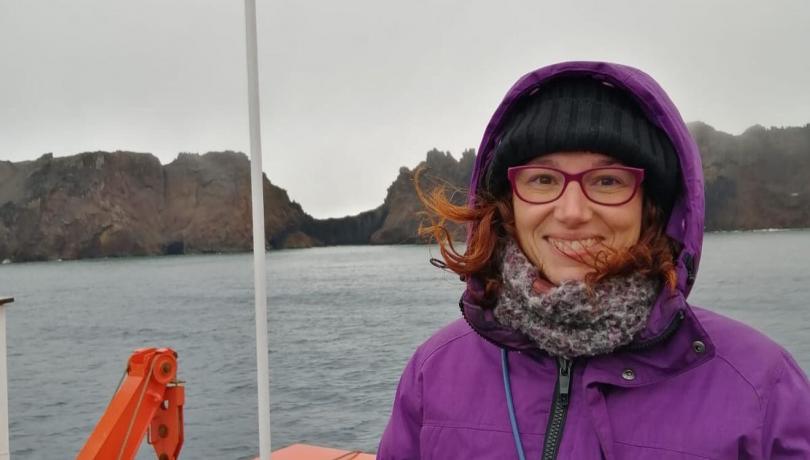Directly from Antarctica, we interview our colleague Andrea G. Bravo, an expert in the study of a very toxic pollutant, mercury.

Andrea’s research focuses on the description of different chemical forms of mercury and among them, methylmercury, the chemical form that accumulates in aquatic trophic chains and poses the greatest danger to human health. In 2019 the researcher received the Raymond L. Lindeman Award for her work on the biogeochemical cycling of mercury in lakes.
1. What project are you going to develop in this Antarctic campaign?
During the ANTOM campaign, led by IDAEA researchers Jordi Dachs and Begoña Jiménez, we will measure the concentration of different pollutants and the microorganisms involved in their transformation. In this context, the objective of my research in this Antarctic campaign is to study the concentration of the different chemical forms of mercury, but especially that of methylmercury.
2. What are the harmful effects of mercury on the health of exposed people?
Mercury poisoning can affect the nervous and immune systems, the digestive system, skin, lungs, kidneys and eyes, which can cause serious health problems. Mercury also has serious effects on fetal and early life development. In fact, the World Health Organization (WHO) lists methylmercury among the ten most hazardous chemicals.
3. Why is it so important to understand the cycle of mercury formation and circulation?
All chemical forms of mercury are toxic, but methylmercury is the chemical form to which we are most exposed, as it accumulates in food chains. Mercury accumulates in organisms at the base of aquatic food webs such as algae and crustaceans that are part of the plankton. As we move up in the food chain, concentrations increase. Thus, in omnivorous fish such as cod, we find higher concentrations than in plankton. In turn, in carnivorous fish such as swordfish, bluefin tuna, shark (dogfish, mako, blue shark) and pike, it is found in higher concentrations than in omnivorous fish and plankton. It is therefore important to avoid over-consumption of carnivorous species. Therefore, understanding the sources and locations of methylmercury formation is key to predicting and, if possible, reducing the concentration of methylmercury in the ocean, which is the main source of fish.
4. What is the current state of the mercury cycle?
Currently, it is estimated that, due to anthropogenic activities, the amount of mercury has increased three to five times in all compartments of the planet, including rivers, soils, lakes and oceans.
5. Where do mercury emissions come from? What is the origin?
There are natural and anthropogenic emissions. Natural sources include volcanic activity, natural soil erosion and forest fires. Emissions produced by human activities include primary mercury extraction, gold mining and metallurgy of other metals. In addition to these sources, fossil fuel combustion, natural gas purification and industrial activities such as cement manufacturing, among others, stand out.
6. Why is this especially a concern in cold areas?
Mercury and other volatile pollutants circulate in the atmosphere. When they reach high latitudes such as the Arctic or Antarctica, the air cools and therefore increases in density and descends. For example, in the case of the Nordic countries that have soils enriched in organic matter, many pollutants, including mercury, are bound to this organic matter. As a result, much of the mercury emitted during the industrial revolution has accumulated in the soils of northern Europe. In Antarctica and the Arctic, pollutants are deposited in ice and snow and during the melting season enter the ocean.
7. What is the role of bacterial activity in the formation of methylmercury?
Microorganisms play a key role in the mercury cycle: they are involved in almost every reaction or transformation of the mercury cycle. For example, there are bacteria that form methylmercury and others that degrade it. Therefore, knowing the diversity of these microorganisms and understanding the factors that determine their activity is a priority of my research.
8. What is the role of sediments and how does it relate to your research?
Sediments accumulate contaminants and are excellent historical records. Above all, deep sediments help us understand historical emissions and reconstruct past events. More recent sediments, on the other hand, are in contact with the water column and are very reactive areas, which can affect water quality.
9. What solutions can be implemented to prevent the accumulation of mercury in food chains?
It has been shown that reducing mercury emissions leads to a reduction of mercury levels in the environment. This is why the Minamata Convention was created, a global agreement that aims to reduce and eliminate emissions of mercury and its compounds to protect human health and the environment from these anthropogenic emissions.